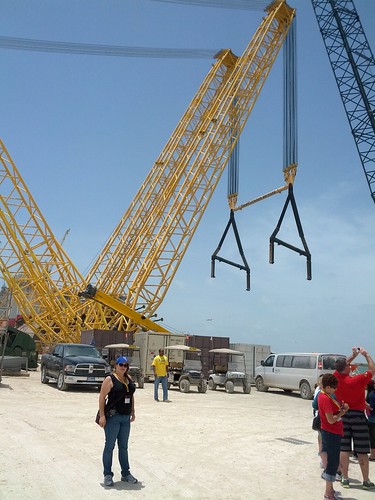1- they impacted the most people
2- there's the most public domain information on them, so they are the easiest to talk about
3- they are reflective of general trends
There are other small and medium firms that have gone through similar struggles (or might even be thriving), but the big ones are the easiest to talk about.
I also ended on somewhat of a down note. I'd like to throw out a few ideas on some various projects that might help right the ship. Some of them are Megaprojects, which carry special risks as megaprojects are by definition extremely complex, difficult to execute, but, if successfully executed, can be home runs. A poorly executed project could have the result of looking like Mississippi's Gulfport Port expansion debacle or the Kemper Gassification Plant boondoggle. Always be on your toes...
Just throwing a few ideas out there, with simple pro/con's for brainstorming, in no particular order:
* LIGTT (nicknamed "Leg-It") or similar truly deepwater port.

(Photo: Advocate).
Pro: Deepwater port would built upon increased traffic from the Neopanama Canal. Draft does limit access to the Port of New Orleans, especially during the fall when river levels fall and harvests (exports) are at their strongest.
Con: Expensive ($2B?), lots of dredging. The biggest risk is vulnerability to a big storm. A monster storm would wipe the slate clean, like what happened to Gulfport after Katrina. On the flip side, quite a few Gulf Coast ports are extremely vulnerable to a direct hit from a monster storm, so LGITT wouldn't be that much riskier than the competition. Heck, the Port of Houston got walloped and it's well inland and was hit by merely a Category 4.
* Gas-To-Liquids (GTL).
Pro: utilize cheap natural gas to make higher value added products, usually diesel and lubricants.
Con: CAPEX intensive. It requires a large spread in price between gas feedstock and (high) liquids price. Gas prices are currently cheap, but liquids pricing not enough right now to really justify the initial capital investment. Both Shell and Sasol have recently pulled the plug (after strongly considering it). It might happen someday, but not likely anytime soon. Something like more efficient catalysts might cause a breakthrough, though. Don't count it completely out.
* Liquefied Natural Gas (LNG)
Pro: there's already one large LNG export terminal working and many more are planned.
Con: I have mixed feelings about this one. I worry about too much a rush towards this at once where too many players enter at once and the whole market tanks. I'm not the only one thinking that. I also wonder if it's not better to add as much value to raw materials as possible before export rather than just exporting our natural resources on the commodity market.
* Space-X and/or NASA heavy lift vehicle built at Michoud
Pro: Hell yeah! Huge manufacturing facility with access to the Intracoastal Waterway allows really big things to be chucked into space.
Con: $$$$$$$$$$$$$$ :-(. I can at least re-read The Martian sometime and dream.
* Deepen the Intracoastal waterway
Pro: this would benefit many coastal areas, but especially Louisiana.
Con: this would have to be done at the federal level. The costs would increase exponentially the deeper you went. Right now, it's ~12'. If you went deeper, say, 25', that gets really expensive fast (at least in certain segments).
* A second Baton Rouge bridge across the Mississippi.
Pro: Anyone who's driven through Baton Rouge between Noon and 6 PM on a weekday in the past 20 years will tell you it's sorely needed.
Con: Probably >$1B. The state is broke and would be the most obvious candidate to fund much of the bridge. PPP looks to be the popular choice at the moment and that means tolls, probably high ones, for quite a while. Louisiana only has a handful of bridges with tolls (despite having lots of waterways) and don't like paying tolls.
* Electrified freight (passenger?) rail
Pro: This was one that really fascinated me on The Oil Drum (back when that was still kicking). It can be a silver BB that hits lots of birds with one stone.
Con: would be most effective if done on an interstate basis.
* River Diversion South of New Orleans

Pro: We could start cleaning up the environmental mess we left in this state. Can help buffer against future storm surges. 2 paired diversions (one on the eastbank, one on the westbank somewhere downriver from English Turn).
Con: I might be dead before this thing ever gets off the ground. It's been discussed for ages, but money and permitting are perennial headaches.
Just something to noodle a while.







